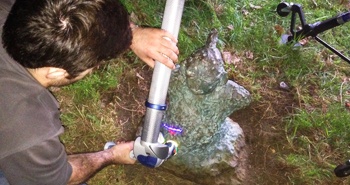
The manufacturing industry is experiencing a surge in productivity which is leading to an ever increasing need to verify that the parts being produced meet the specified requirements. When timelines are critical and tolerances are growing ever tighter, it is imperative that the quality process involved in reinforcing the part's requirements consistently adds value to manufacturing. The parts manufactured today have increasingly demanding measurements, and are outgrowing the traditional systems used to measure or reverse engineer them. 3D scanning is a cost-effective solution that brings accuracy and versatility to the evolving landscape of the metrology industry.
4 Key Benefits of 3D Scanning
- Coverage - In just a matter of minutes, 3D scanners can collect and measure millions of data points on the surface of an object. This efficiency was not possible before the technology was introduced, which is why it has seen such explosive growth in such a short period of time.
- Speed - Manual measurement takes a long time and is limited by the amount of data that can be practically collected. 3D scanning offers a fast way to automatically collect millions of data points at the speed of light. This reduces the time it would take to traditionally produce CAD models of prototypes or 2D drawings for reverse engineering. By increasing the rate of surface data acquisition, 3D scanning brings unparalleled speed to the inspection process.
- Accuracy - As the technology has improved, the accuracy of 3D scanning has increased over time. Currently, modern scanners provide a high degree of accuracy which is only expected to improve as the ability to collect more and better data points increases.
- Cost - The price of 3D scanning is competitive with other dimensional measurement technologies, especially when you factor in the time savings. Many 3D scanners are also easier to use, which helps to maintain lower training costs.
The type of 3D scanning used will be dependent on the part's surface characteristics such as reflectivity, transparency, and roughness. In some cases, structured light scanning is not an appropriate method because diffraction and reflection can affect the measurements. The best way to decide which type of scanning makes the most sense for your application is to work with a qualified 3D scanning provider that has extensive experience with multiple scanning technologies.
Since 1987, Q-PLUS Labs possesses dimensional metrology expertise and maintains cutting edge 3D scanning techniques. If you need an in-house solution for your application, as a metrology equipment reseller, Q-PLUS Labs works with cutting edge 3D scanner manufacturers to provide customers with objective information on the best fit solution for their application. Contact us today to learn how we can add value to your quality process.





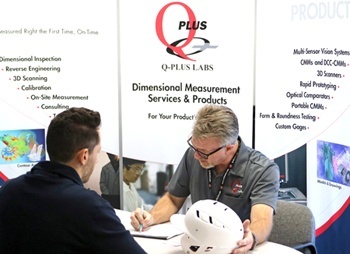


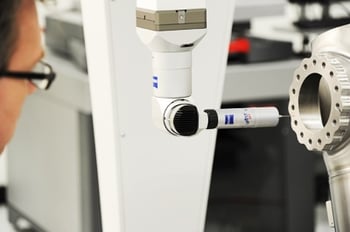
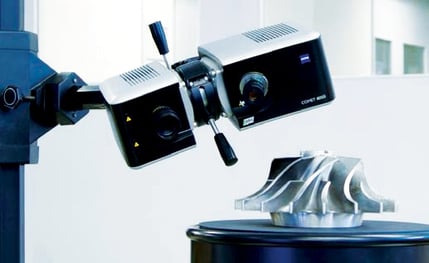

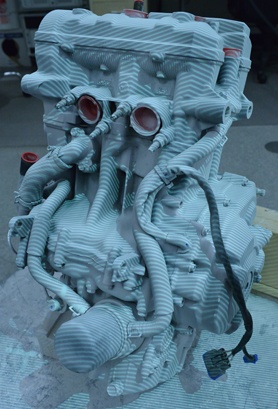 This year, California State University, Fullerton's Formula SAE is using a Yamaha FZ-07 motorcycle engine which has increased displacement for their new race car design. The new design for the chassis will include a space frame as well as a carbon fiber driver cell. The space frame is created by welding steel tubes together and attaching them to the cockpit and the engine housing, as well as the drive train. Unlike the team's last design which was a stressed engine, this design will be mounted to the inside of the space frame. Weighing 20 to 30 pounds less than the team's original engine, this choice also offers more torque and faster acceleration without creating a heavier car which would give the team an edge against their competition.
This year, California State University, Fullerton's Formula SAE is using a Yamaha FZ-07 motorcycle engine which has increased displacement for their new race car design. The new design for the chassis will include a space frame as well as a carbon fiber driver cell. The space frame is created by welding steel tubes together and attaching them to the cockpit and the engine housing, as well as the drive train. Unlike the team's last design which was a stressed engine, this design will be mounted to the inside of the space frame. Weighing 20 to 30 pounds less than the team's original engine, this choice also offers more torque and faster acceleration without creating a heavier car which would give the team an edge against their competition.
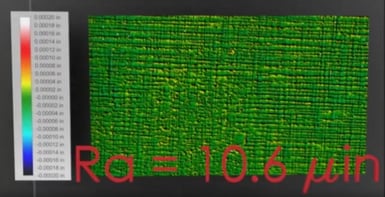 To analyze the exact amount of wear, Q-PLUS Labs performed a surface roughness analysis to confirm the wear on the unused surface of a traditional friction-fit lock versus the wear experienced by Extreme Components LP’s DAT locks after multiple uses. This was accomplished using
To analyze the exact amount of wear, Q-PLUS Labs performed a surface roughness analysis to confirm the wear on the unused surface of a traditional friction-fit lock versus the wear experienced by Extreme Components LP’s DAT locks after multiple uses. This was accomplished using 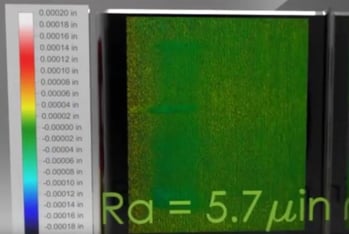 In comparison to the friction-fit lock, Extreme Components’ DAT lock that had been used by a multinational medical device manufacturer for 4 years of near continuous service, cycling every seven seconds with a 2,300 pound load yielding more than 10 million cycles, was measured to have a surface roughness of only 5.7 micro inches. The data of the surface map displays better uniformity than the friction-fit lock, and visual inspection shows the DAT lock’s mirror-like surface and no galling.
In comparison to the friction-fit lock, Extreme Components’ DAT lock that had been used by a multinational medical device manufacturer for 4 years of near continuous service, cycling every seven seconds with a 2,300 pound load yielding more than 10 million cycles, was measured to have a surface roughness of only 5.7 micro inches. The data of the surface map displays better uniformity than the friction-fit lock, and visual inspection shows the DAT lock’s mirror-like surface and no galling.
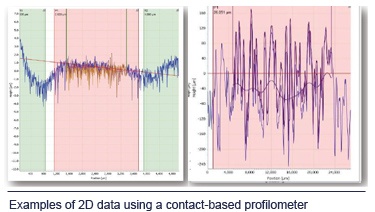 As the name suggests, this type of nano measurement solution will come in contact with the piece to be measured in order to determine its dimensions. The two main types of equipment capable of these measurements are stylus profilometers and the atomic force microscope. Both have been in use for some time and use extremely sensitive styluses to collect the measurement data required.
As the name suggests, this type of nano measurement solution will come in contact with the piece to be measured in order to determine its dimensions. The two main types of equipment capable of these measurements are stylus profilometers and the atomic force microscope. Both have been in use for some time and use extremely sensitive styluses to collect the measurement data required.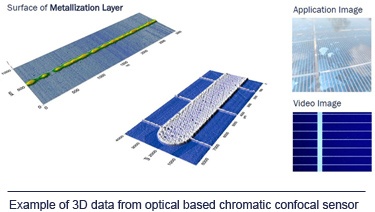 Optical-based nano-measurement technologies are quickly becoming the go-to devices for measurements at the nano level. Since these techniques do not touch the surface of the piece to be measured, there is no risk that small or delicate parts will be damaged or moved during measurement. As an added feature, optical measurements are also done more quickly than traditional contact-based measurements, and typically have an innate ability to obtain 3D measurements in addition to 2D data.
Optical-based nano-measurement technologies are quickly becoming the go-to devices for measurements at the nano level. Since these techniques do not touch the surface of the piece to be measured, there is no risk that small or delicate parts will be damaged or moved during measurement. As an added feature, optical measurements are also done more quickly than traditional contact-based measurements, and typically have an innate ability to obtain 3D measurements in addition to 2D data.
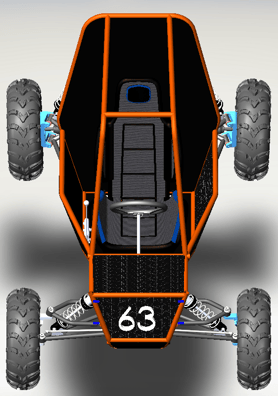 A little background on the rigorous Baja SAE race—it originated in 1976 at the University of South Carolina as a comprehensive engineering competition with the objective for students to function as a team and not only design, build, test, promote, and race a vehicle, but also raise financial support while balancing the demands of their course work. In order to compete as formidable opponent at the 2016 Baja SAE race, the final single-seat, all-terrain sporting vehicle is comprised of parts machined by CSUF’s Baja team.
A little background on the rigorous Baja SAE race—it originated in 1976 at the University of South Carolina as a comprehensive engineering competition with the objective for students to function as a team and not only design, build, test, promote, and race a vehicle, but also raise financial support while balancing the demands of their course work. In order to compete as formidable opponent at the 2016 Baja SAE race, the final single-seat, all-terrain sporting vehicle is comprised of parts machined by CSUF’s Baja team.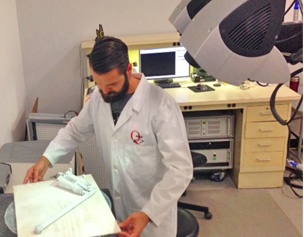 cle’s ability to successfully navigate the race due to the challenging track. CSUF’s Baja team requested Q-PLUS Labs to 3D scan the cutting brake that provided the team with measurement data from which they can derive the best fit area of the car to mount the brake. Using the
cle’s ability to successfully navigate the race due to the challenging track. CSUF’s Baja team requested Q-PLUS Labs to 3D scan the cutting brake that provided the team with measurement data from which they can derive the best fit area of the car to mount the brake. Using the 
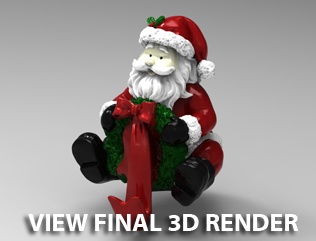
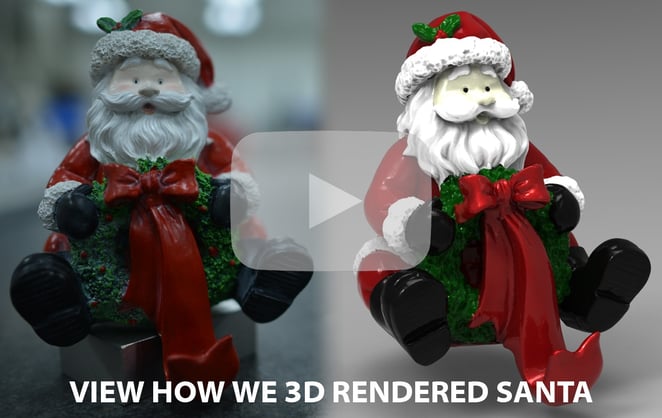

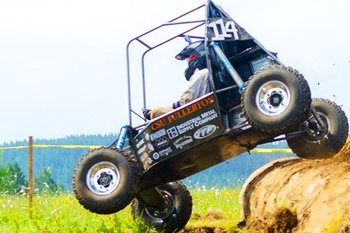 Before building their vehicle, CSUF's Baja team designed a virtual rendering of it in Solidworks, a 3D CAD design software. Because each piece of the car was hand machined, the team needed accurate measurements of the car’s calipers before proceeding with the build. Calipers are essential to the vehicle’s ability to stop and are one of the critical components of a car’s breaks. The challenging track consisted of rough terrain, making the measurements extremely vital to vehicle’s ability to successfully navigate the race.
Before building their vehicle, CSUF's Baja team designed a virtual rendering of it in Solidworks, a 3D CAD design software. Because each piece of the car was hand machined, the team needed accurate measurements of the car’s calipers before proceeding with the build. Calipers are essential to the vehicle’s ability to stop and are one of the critical components of a car’s breaks. The challenging track consisted of rough terrain, making the measurements extremely vital to vehicle’s ability to successfully navigate the race.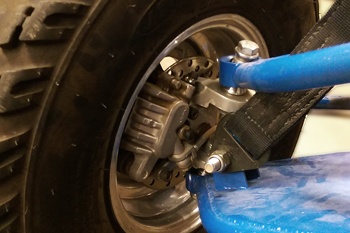 ScanArm HD
ScanArm HD
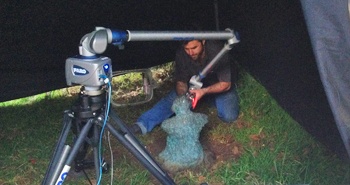 Nam June Paik designed this installation which is composed of televisions paired with Buddhas watching them to depict extended contemplation. As an integral aspect of UCSD's landscape, the university sought to preserve the statues via 3D scan data in case the statues would need to be recreated in detail. For this particular application, Q-PLUS Labs' engineers used white light and laser scanning technology, specifically the
Nam June Paik designed this installation which is composed of televisions paired with Buddhas watching them to depict extended contemplation. As an integral aspect of UCSD's landscape, the university sought to preserve the statues via 3D scan data in case the statues would need to be recreated in detail. For this particular application, Q-PLUS Labs' engineers used white light and laser scanning technology, specifically the 